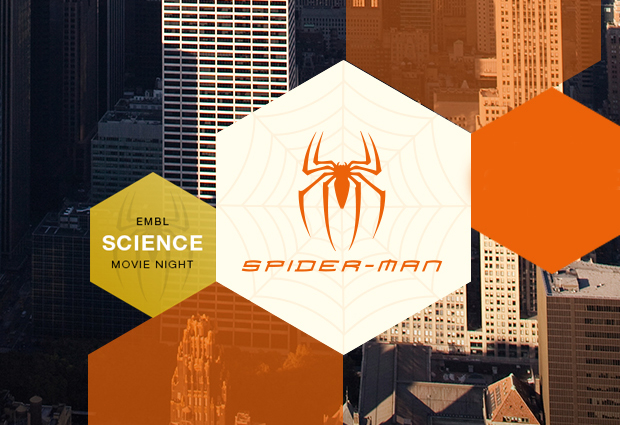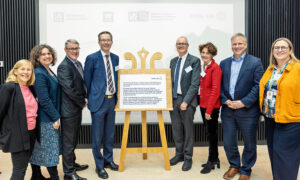
Science of Spider-Man
It all began with a familiar, spine-tingling refrain…“Spider Man, Spider Man, does whatever a spider can...” It punctuated the chatter of curious adolescents and the aromatic pop of cinema snacks, and transformed the EMBL Advanced Training Centre in Heidelberg from a state-of-the-art conference venue into an atmospheric movie theatre, setting the scene for the Laboratory’s first ever Science Movie Night.

Science and fiction
“You’re quite the science whiz,” observes super-villain Norman Osbourn – aka the Green Goblin – on meeting Peter Parker in the Spider-Man film. From a studious young protagonist to designer genetics in lustrous laboratory settings, the 2002 superhero classic is packed with science references and action – but how to unravel the real from the surreal? EMBL PhD students Nade Abazova and Johanna Bischof lent their insight to scientific aspects of Spider-Man at the event hosted by Friends of EMBL, revealing some of the secrets of the most famous spider bite in movie history to the eager ears of the local audience.
Bite of reality
First things first, could superpowers really be transferred by the bite of a “genetically designed super-spider”? Abazova, a geneticist working on nerve cells, explored this staple of superhero science. From banana farming to dog breeding, she described how forms of genetic engineering have been around for many thousands of years – combining the qualities of three different species into one super-spider is plausible, but could its bite really initiate an overnight transformation into a web-wielding super human?
Changes could be possible, but most likely it would have just been a very hairy man!
With engaging examples – including a fluorescing fish – Abazova explained that foreign DNA, such as that of a super-spider, could only be introduced into cells via a ‘gene taxi’ (also known as a ‘vector’). Molecular biologists commonly use viral vectors to deliver genetic material into cells – the spider bite must have carried a powerful virus that could insert its own genome into cells, forcing them to synthesise viral DNA, or in this case, superhero spider DNA. But to alter DNA in every single cell and affect such changes as we see in Peter, the genetic material must be introduced at the one-cell zygote stage – that is, the fertilised egg. “If the spider bite had occurred at this point and we had waited 20 years, changes could be possible, but most likely it would have just been a very hairy man!” she revealed.
Web of lies?
Perhaps the most distinguishing of Spider Man’s superpowers is his ability to generate spider silk, from which he swings effortlessly between skyscrapers in the urban canyons of Manhattan. It was the turn of cell biologist Bischof to investigate the science behind the superhero’s steel-strong silk threads. With some clever calculations, she showed that spider silk – the strongest known natural fibre – could have easily borne Peter as well as his burdens of collapsed masonry and busloads of people in peril, and much more besides.
Luckily we don’t have to watch Peter pull down his pants every time he uses his web!
Comparing it to other natural and manmade materials such as human hair, nylon, steel and newly developed carbon nanotubes, Bischof explained the science behind spider silk’s strength and durability. To round off discussions, she threw in a couple of fun facts: that theoretically you could reach faster speeds running than swinging with even the longest rope, and that spider silk usually comes out of the spider’s rear, not its legs – “Luckily we don’t have to watch Peter pull down his pants every time he uses his web!” she laughed.
Movie magic
“Our aim with Science Movie Night is to educate and excite our local communities, young and old, as well as bust popular myths and misconceptions about the life sciences, research and related activities at EMBL,” explains event organiser Julia Schaft. All presentations and discussions were in German, with free admission and snacks. The inaugural event was a resounding success, with lively discussions continuing long after the popcorn dispenser had cooled, spilling out of the auditorium and onto the complimentary buses that ferried visitors back to the city centre. Preparation for the next event has already started, planned for autumn 2015.


